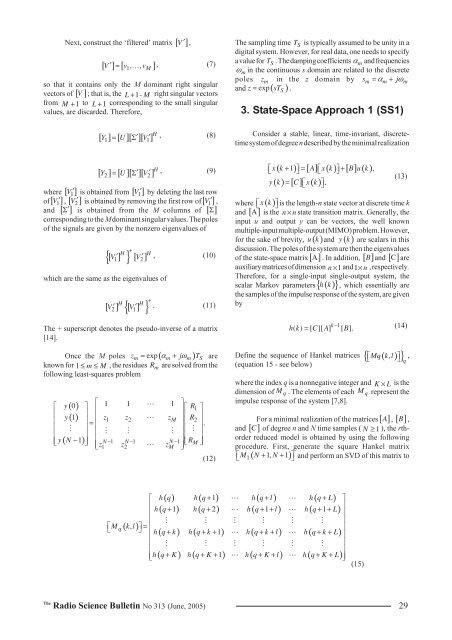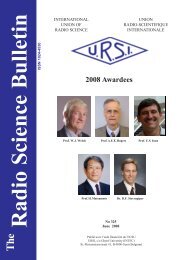for k = 0,1, …, N − 1 , where N is the number of timesamples, x()k is the noise-free data, is the noise sequence,cmand are the amplitudes and phases of the sinusoids,αmand ω m are the damping factors and angular frequencies,M is the number of complex exponentials to be determined,and T s is the sampling period. To express y()k in terms ofpoles z m in the z-domain (right side of (1)), definej mm = (2)mR c e φThese three methods and the procedures for obtainingthe associated time-domain impulse-response sequencesare summarized. Then the accuracies and execution timesof the methods are compared by considering five examples:a thin conducting wire structure; a perfectly conductingsphere; a finite closed cylinder; a dielectric sphere; and acomposite metallic-dielectric sphere.2. Total Least Squares MatrixPencil Method (TLS-MPM)( m j m)Tsm = +(3)z e α ωwhere R m are complex residues. Since (1) approximatesthe complete discrete time-domain response (which includesboth early-time and late-time responses) by superposingdamped sinusoids, the complex resonant poles of (3) can bedifferent from the poles determined with a numerical solutionof the corresponding electric-field integral equation (EFIE),which seeks complex values of the frequency that make thedeterminant of the impedance matrix zero.In this paper, we are interested in the minimum orderof the approximation in terms of accuracy and running time.It is well known that the Matrix Pencil and State-SpaceMethods generate very similar results for the exact-datacase, have minor differences for the noisy-data case [7], andare equivalent to a first-order approximation [1] in thevalues of the variance of the poles from additive noise in thedata. Both methods use the properties of a Hankel matrixand the singular value decomposition (SVD), which play animportant role in many signal-processing applications. Themost pertinent feature of the Hankel matrix is that its rankfor the ideal case reflects the order of the correspondingsystem – hence the number of nonzero singular valuescorresponds to the rank of the matrix. Consequently, the setof singular values will be used to determine the rank, as wellas to estimate the deviation of the matrix from a lower rankone [8].Although many variations of the Matrix-Pencil andState-Space Methods appear in the literature, only threeapproaches are chosen for this study: the Total Least SquaresMatrix Pencil Method (TLS-MPM) [9]; the normal statespaceapproach (SS1) using SVD [8]; and the state-spaceapproach (SS2) using the Extended Impulse ResponseGrammian [10-12]. In the selected state-space approaches,Markov parameters (which are related to the impulseresponse of the system) are used to obtain the poles of thesystem. In contrast to traditional signal processing, eachmethod is applied directly to the data and not to a covariancematrix – that is, this methodology is deterministic ratherthan statistical. The allure of a deterministic model is thatthe parameters of interest have smaller Cramer-Rao boundsthan a stochastic model [13] in the presence of backgroundnoise.The TLS-MPM approach is an efficient and robustmethod to fit noisy data with a sum of complex exponentials[9]. To implement the TLS-MPM, one forms the matrix[] Y ,[] Y =() 0 () 1 " ()() 1 ( 2) " ( + 1)⎡ y y y L⎢⎢y y y L⎢ # # #⎢⎢⎣y N L y N L y N( − −1) ( − ) " ( −1) ⎥⎦( N− L ) × ( L+1)from the N samples { () ( )}y 0 ,…,y N-1 of the input y,where the pencil parameter L is less than N. For efficientnoise filtering, L is chosen between N/3 and N/2. Then theSVD of [ Y ] is given by [14]⎤⎥⎥⎥⎥(4)[] Y = [][][] U Σ VH(5)In (5), [ U]is an ( N -L) ( N -L)columns are the eigenvectors[ Y][] Y H , [ ]( L 1) ( L 1 )HY Y , []× unitary matrix whoseV is an+ × + unitary matrix whose columns are theeigenvectors[ ][] Σ is a diagonal matrix containingthe r positive singular values of [] Y , and r is the rank ofY . The superscript H denotes conjugate transpose and[]() ( ) ()s 1 ≥ s 2 ≥…≥ s r > 0.At this stage, the number of exponentials isdetermined by the ratio of the smallest singular value s()rto the largest one s () 1 . For a singular valueσ c , considerthe relationσ cs() 1− p≈ 10 , (6)where p is the number of significant decimal digits in thedata. Equation (6) is used to cull the singular values. Forexample, if the data is accurate to 3 significant digits, thenthe singular values for which the ratio in (6) is less than10 -3 are essentially noise singular values, and they will notbe used.28The<strong>Radio</strong> <strong>Science</strong> <strong>Bulletin</strong> No <strong>313</strong> (<strong>June</strong>, <strong>2005</strong>)
Next, construct the ‘filtered’ matrix [ V ′],[ V ] [ v v ]′ = 1 , ! , , (7)Mso that it contains only the M dominant right singularvectors of [ V ]; that is, the L+ 1-Mright singular vectorsfrom M + 1 to L + 1 corresponding to the small singularvalues, are discarded. Therefore,[ Y ] [ U][ ′][ V′]H1 1[ Y2] [ U][ ′][ V2′]where [ V 1′ ] is obtained from [ 1]of[ V 1′ ], [ 2]and [ ′]= Σ , (8)H= Σ , (9)V ′ by deleting the last rowV ′ is obtained by removing the first row of[ V 1′ ],Σ is obtained from the M columns of [] Σcorresponding to the M dominant singular values. The polesof the signals are given by the nonzero eigenvalues of{[ ]H +V1 } [ V2]H′ ′ , (10)which are the same as the eigenvalues ofH{ }H[ V ] [ V ]2 1+′ ′ . (11)The + superscript denotes the pseudo-inverse of a matrix[14].zm = m + j m TSareknown for 1 ≤m≤ M , the residues R m are solved from thefollowing least-squares problemOnce the M poles exp( α ω )⎡ y()0 ⎤⎡ 1 1 " 1 ⎤⎡ R1⎤⎢ ⎥⎢⎥y()1 z1 z2 z⎢M R⎥⎢ ⎥⎢" ⎥ 2= ⎢ ⎥.⎢⎢ ⎥# ⎥⎢ # # # ⎥⎢ # ⎥⎢ ⎥ ⎢⎣y( N −1)⎥⎦ N−1 N−1 N−1Rz M1 z2z⎢⎣ ⎥⎢ ⎦⎣" M ⎥⎦(12)The sampling time T S is typically assumed to be unity in adigital system. However, for real data, one needs to specifya value for T S . The damping coefficients αmand frequenciesωmin the continuous s domain are related to the discretepoles z m in the z domain by sm = αm + jωmz = exp sT .and ( )S3. State-Space Approach 1 (SS1)Consider a stable, linear, time-invariant, discretetimesystem of degree n described by the minimal realizationx( k + ) = [ A] x() k + [ B] u()k() = [ ] ⎡ () ⎤,⎡⎣ 1 ⎤⎦ ⎡⎣ ⎤⎦,y k C ⎣x k ⎦(13)where ⎡⎣x()k ⎤⎦is the length-n state vector at discrete time kand [ A ] is the n× nstate transition matrix. Generally, theinput u and output y can be vectors, the well knownmultiple-input multiple-output (MIMO) problem. However,for the sake of brevity, u()k and y()k are scalars in thisdiscussion. The poles of the system are then the eigenvaluesof the state-space matrix[ A ]. In addition, [ B]and [ C]areauxiliary matrices of dimension n × 1 and1× n , respectively.Therefore, for a single-input single-output system, thescalar Markov parameters { h()k }, which essentially arethe samples of the impulse response of the system, are givenbyk−1= (14)hk ( ) [ C][ A] [ B].{ ⎤}Define the sequence of Hankel matrices ⎡Mq( k,l)(equation 15 - see below)where the index q is a nonnegative integer and K× L is thedimension of M q . The elements of each M q represent theimpulse response of the system [7,8].For a minimal realization of the matrices[ A ], [ B ],and [ C ] of degree n and N time samples ( N ≥ 1 ), the rthorderreduced model is obtained by using the followingprocedure. First, generate the square Hankel matrix⎡⎣M1 ( N + 1, N + 1)⎤⎦ and perform an SVD of this matrix to⎣⎦q,h() q h( q+ 1) " h( q+ l) " h( q+L)( + 1) ( + 2) " ( + 1+ ) " ( + 1+)⎡⎤⎢⎥⎢h q h q h q l h q L⎥⎢ # # # # # # ⎥⎡⎣Mq( k,l)⎤=⎦ ⎢ ⎥⎢h( q+ k) h( q+ k + 1) " h( q+ k+ l) " h( q+ k+L)⎥⎢ # # # # # # ⎥⎢⎥⎢⎣h( q+ K) h( q+ K + 1) " h( q+ K + l) " h( q+ K + L)⎥⎦(15)The<strong>Radio</strong> <strong>Science</strong> <strong>Bulletin</strong> No <strong>313</strong> (<strong>June</strong>, <strong>2005</strong>) 29
- Page 1 and 2: Radio Science BulletinISSN 1024-453
- Page 3 and 4: EditorialJune in December?Yes, this
- Page 5 and 6: URSI Accounts 2004In 2004, a year p
- Page 7 and 8: EURO EUROA2) Routine Meetings 7,315
- Page 9 and 10: URSI AWARDS 2005The URSI Board of O
- Page 11 and 12: Guest Editors’ RemarksOn February
- Page 13 and 14: UWB and the corresponding signal pa
- Page 15 and 16: Radar / CommunicationsBand TypeElec
- Page 17 and 18: of the spectrum is required to comp
- Page 19 and 20: Bandwidths f l / GHz f h / GHz B F
- Page 21 and 22: Figure 3a. A time-domain representa
- Page 23 and 24: Bandwidths f l / f c f h / f c B F
- Page 25 and 26: Bandwidth f l / f c f h / f c B F C
- Page 27: Quantitative Comparison BetweenMatr
- Page 31 and 32: whereH[ P ] [ U][ ][ V] ,N= Σ (27)
- Page 33 and 34: CPU Time [sec]250200150100MPMSS1SS2
- Page 35 and 36: -10-20MPMSS1SS2-30-40RMSE [dB]-50-6
- Page 37 and 38: RMSE [dB]-45-50-55-60-65-70MPMSS1SS
- Page 39 and 40: An Ultra-Compact Impulse-Radiating
- Page 41 and 42: Figure 3. UCIRA-1 splitter/balun.th
- Page 43 and 44: Figure 9. UCIRA-2 in stowed configu
- Page 45 and 46: activated first in the deployment s
- Page 47 and 48: Figure 20. Theoretical gain ofUCIRA
- Page 49 and 50: Triennial Reports CommissionsCOMMIS
- Page 51: y the Special Section Editors, and
- Page 55 and 56: 3.2 Activities of URSI-Commission C
- Page 57 and 58: It already has been decided that th
- Page 59 and 60: SCOR (Scientific Committee on Ocean
- Page 61 and 62: COMMISSION GThis triennium report w
- Page 63 and 64: GNSS-LEO occultation is a very impo
- Page 65 and 66: CPEA Contacts: Shoichiro Fukao, Pro
- Page 67 and 68: The group wishes to continue as an
- Page 69 and 70: total of 109 oral papers (24 thereo
- Page 71 and 72: surface, to compensate for the rema
- Page 73 and 74: XXVIIIth General AssemblyNEWLY ELEC
- Page 75 and 76: Décide1. d’accepter l’invitati
- Page 77 and 78: satellite observation, bottomside s
- Page 79 and 80:
ETTC ‘05EUROPEAN TEST AND TELEMET
- Page 81 and 82:
IRI 2005 WORKSHOPNEW SATELLITE AND
- Page 83 and 84:
financial and logistics issues conn
- Page 85 and 86:
CONFERENCE ANNOUNCEMENTS36 TH COSPA
- Page 87 and 88:
December 2006APMC 2006 - 2006 Asia-
- Page 89 and 90:
The Journal of Atmospheric and Sola
- Page 91 and 92:
SCIENTIFIC COMMISSIONSCommission A
- Page 93 and 94:
Commission E : Electromagnetic Nois
- Page 95 and 96:
Commission J : Radio AstronomyChair
- Page 97 and 98:
URSI MEMBER COMMITTEESAUSTRALIA Pre
- Page 99 and 100:
ALPHABETICAL INDEX AND CO-ORDINATES
- Page 101 and 102:
BRUSSAARD, Prof. dr.ir. G., Radicom
- Page 103 and 104:
FEICK, Dr. R., Depto. de Electronic
- Page 105 and 106:
SAUDI ARABIA, Tel. +966 1-4883555/4
- Page 107 and 108:
E-mail loulee@nspo.gov.tw (94)LEE,
- Page 109 and 110:
O’DROMA, Dr. M., Dept. of Electri
- Page 111 and 112:
+30 2310 998161, Fax +30 2310 99806
- Page 113 and 114:
TURSKI, Prof. A., ul. Krochmalna 3
- Page 115 and 116:
Information for authorsContentThe R
















